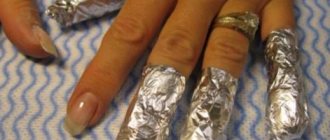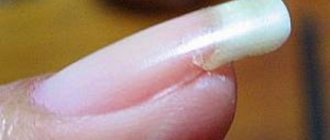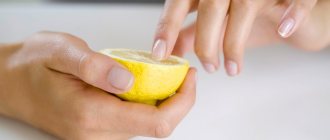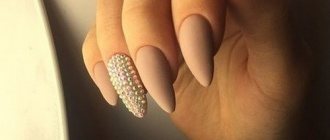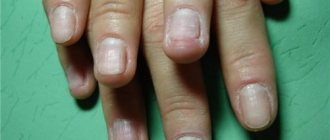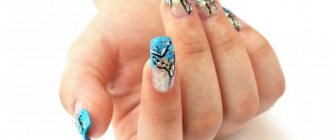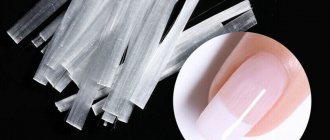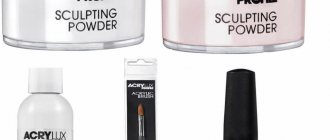Every girl wants to be irresistible. To make your look complete and stylish, even little things like nails can play an important role. Beautiful and well-groomed nails make a woman sexy and attractive. But, unfortunately, not everyone has been blessed with such beauty by nature. But don’t worry, modern cosmetology will help you solve the problem of ugly and short nails, and you will soon have a new fashionable manicure that will be the envy of your friends.
Nail extension is a simple procedure that will help make your hands neater and your image complete. Before deciding on the procedure, read interesting reviews and watch useful video tutorials about nail extensions.
Cons of nail extensions
- Quite a high cost of the nail extension procedure;
- When preparing the nail, it will be exposed to mechanical devices, damaging it;
- If you come across an unscrupulous master, deformation of the nail may occur;
- You may develop an allergy to the components that make up the extension materials;
- If the extended nail breaks, it breaks in the middle of the nail plate, which is very painful and does not lead to anything good.
- Extended nails require correction, so you will have to find time and money to visit the salon;
- Natural nails become thinner after removing extensions. You will have to spend a lot of effort to get your natural nails in order.
- Gel nails cannot be removed, they will have to be filed off. Only a master can perform such a procedure.
Materials for nail extensions: acrylic and gel - their advantages and disadvantages
At the moment, there are 2 main materials for nail extensions - acrylic and gel.
- Acrylic is a special powder that is mixed with a special liquid. The result is a thick and sticky substance that is applied to the nail. A professional can properly extend acrylic nails, since the acrylic mixture quickly hardens in air. But, with certain skills, acrylic nail extensions can be done at home. After applying the mixture to the nail, it is trimmed, polished and coated. Acrylic nails are very durable, but if you still manage to break them, a specialist in the salon can easily repair the damage. Acrylic nails are easy to remove : using a special product, acrylic is dissolved and removed. The only drawback of acrylic nails is the specific smell of the material, which will accompany you for some time. But then the smell will disappear.
Gel is also a good material for nail extensions. Thanks to the gel, nails are not only strong, but also elastic. The gel allows the nails to breathe and allows moisture to pass through, which is good for the nails. Gel nails harden under the influence of ultraviolet rays, which will not allow fungus to develop on the nail plate in the future. To make the nail stronger, the procedure is repeated several times. When the last layer of gel has hardened, the nail can be given the desired shape and coated with varnish. Gel nails can be done in a salon by an experienced nail technician, but gel nail extensions can be easily done at home if you purchase everything you need for the procedure and study the instructions. The advantages of gel nails include durability (service life can reach up to 5 months). Among the disadvantages are the following: if a nail breaks, it cannot be restored ; you will have to make a new one. Getting rid of gel nails is also difficult. Frozen gel can only be removed by a master by filing .
To be honest, gel and acrylic belong to the same group of “acrylates” , so it’s impossible to say for sure which is better. Each person chooses the most optimal extension option and follows it. At the moment, there is a special technology that allows you to combine acrylic and gel : first acrylic is applied to the nail, which makes the nail stronger, then gel is applied to add shine.
Gel nail extension system
Why do some artists apply gel nails with one coat, while others apply the mixture three times and dry it? The types of gels determine the system of this procedure. Any system has a common stage - preparing the nail plate for gel extensions. Preparation means degreasing the nail plate and cleaning it. Further stages, or more precisely, their number, differ.
Single-phase gel includes all stages of the process - adhesive base, modeling and fixing.
These gels are convenient for working on forms. Single-phase gel can be medium thick or very viscous, the most shiny. Single-phase gel is an economical product. A system using three substances that perform different functions - all three stages are divided into three jars. This is a three-phase gel. When modeling, a sculpting gel is applied, which is then filed off until the nail reaches its natural thickness.
During the second phase, i.e. modeling or building, camouflage gel is often used. It helps bring the nail color closer to natural. Correction when using such a gel may be slightly delayed in time, since the boundaries of the nail and the extended plate are not visible. Such gels are not bright or colored. Most often these are shades of pink, peach and beige. Detachments and errors are not very noticeable.
Before doing gel nails, you should think about why not do nail extensions with biogel. Modern salons use exactly this method of extension. This composition can be applied directly to the nail plate, which does not lose moisture and does not deteriorate. It can be easily removed using regular homemade nail polish removers. Biogel nail extensions help to grow plates for those who have fragile and brittle nails. There are different models of such gels: gel polish, 3D polish, colored varnish. Colored gel polishes are usually used to create drawings and designs. Corrections are made approximately once a month.
All methods of nail extension - with tips, with paper forms, with top forms, with liquid tips
There are several types of nail extensions. Each type is different from each other and has its own advantages and disadvantages.
Extension on tips
Tips are plastic plates that are attached at one end to the nail before applying gel or acrylic. After applying the material, the extended nails are covered with varnish and a design is applied. The color and size of tips can be very diverse. There are liquid tips (reusable forms with which an artificial nail is made. This method does not use disposable forms or tips). An important advantage of liquid tips is the non-use of glue . Glue is the most toxic substance used for any nail extension. Using liquid tips you can:
- Create reusable forms, which significantly saves the budget;
- Create the perfect arched jacket;
- Create unique and complex designs;
- Possibility of creating a pedicure.
Properly selected tips can only use a small part of the nail , which protects your nails. After fixing the tips, the nails can be given any shape or length. Here everything depends only on the imagination and skill of the master.
Form nail extensions
The forms are disposable paper bases, the outer side of which is coated with a special compound, and the inner side is coated with an adhesive component. Paper forms are thrown away after use. There are reusable forms made of metal . These forms are attached to the nail using a metal clip. For subsequent use, the metal mold must be disinfected.
Contraindications for extensions
It is worth noting that in fact there are a number of contraindications to nail extensions. These include, first of all, individual intolerance to the materials used to carry out the procedure.
Nail extensions are not recommended for girls who have fungal diseases. Also, serious contraindications are the presence of a woman in a state of pregnancy, as well as during lactation.
Reviews from experts regarding the nail extension procedure say that in case of certain diseases, it is best to avoid extensions, since due to the nature of the processes in the body, the material will not adhere very well. A number of such diseases include all those that affect the digestive, endocrine, and excretory systems. Moreover, practice shows that the material does not adhere well during the period of use of antibiotics, as well as during and after a course of chemotherapy.
Fingernails are coming off: is it worth extending them? It is worth noting that the described situation is also a significant contraindication to the procedure, since in this case the process of its treatment is vital for the nail plate.
Is it worth getting your nails done before going to the seaside? This is not prohibited, but it is worth remembering that while swimming in salt water, the nail plate is naturally strengthened due to the ingress of useful nutrients into its structure. This will not happen in a situation with extended nails.
Nails after extensions - how to care for them?
Many people believe that it is not necessary to take care of your nails after extensions. But that's not true! Any material does not last forever and requires special care, especially since natural nails tend to grow. There is no way to do this without correction of the extended plates .
To make your nails look beautiful and not break, it is important to follow some rules:
- Neither gel nor acrylic nails tolerate acetone. Therefore, choose nail polish remover without acetone , use non-aggressive household chemicals;
- Do not use wire cutters or scissors. A polisher and file for extended nails will help you adjust the length of your nails;
- Do not hit your nails on a hard surface , do not drop heavy objects on them and be careful;
- Take care of your cuticles. To prevent hangnails from forming and to keep the cuticle moisturized, moisturize it with vegetable oils. If your cuticle grows too quickly, use a special product to slow down its growth;
- Before a manicure, do not take baths , use only softening oils. This will help prevent damage to your nails;
- If you dive into a cold pool after a hot bath, you can damage your nails ;
- When painting your extended nails with varnish, use only high-quality varnishes . Pay attention to the consistency and shelf life of the varnish;
- It is recommended to go for correction at least once every 3 weeks ;
- Do not resort to hardware manicure services. It contributes to weakening and brittleness of nails;
- Don't try to fix a broken nail yourself;
- It is recommended to remove extended nails only in salons;
- Do not cover your extended nails with a thick layer of varnish.
These are the basic rules for caring for extended nails, following which you will preserve their beauty and durability.
Extension and pregnancy: caution during the procedure
Pregnancy is an important stage in a woman’s life. However, you don’t want to take off your beautiful extended nails. Can pregnant women have them? Why do some doctors not pay attention to the presence of such a manicure, while others immediately advise removing it?
Pregnant women should be aware that the gel contains methacrylate.
However, its dose is negligibly small to cause defects in babies or harm pregnant women. Extension and correction require face masks. They are needed in order to reduce the amount of inhaled sawdust. Files and scissors must be exclusively individual to avoid infection. Detachments of the material and frequent correction are possible due to changes in hormonal levels. In good salons, pregnant women are provided with a couch during the procedure; the highest quality materials are used. Sanitary violations and mistakes are dangerous for the health of mother and child. However, there are no particular contraindications to the procedure.
The gel extension procedure has a significant number of advantages. The procedure can be done in a salon or at home, provided you have all the necessary tools and skills. During pregnancy, you can also extend your nails, taking certain precautions.
How much does nail extension cost in salons in Moscow and St. Petersburg?
There are many salons in Moscow and St. Petersburg that provide nail extension services. Prices may vary depending on the specialization of the craftsmen and the classification of the salon . On average, for nail extensions in Moscow you will have to pay 2500 rubles , correction will cost you 1300 . In St. Petersburg, for nail extensions, you will have to pay 2200 rubles , and correction will cost 1000 rubles . Choose salons with a good reputation and professional craftsmen so as not to regret your choice!
